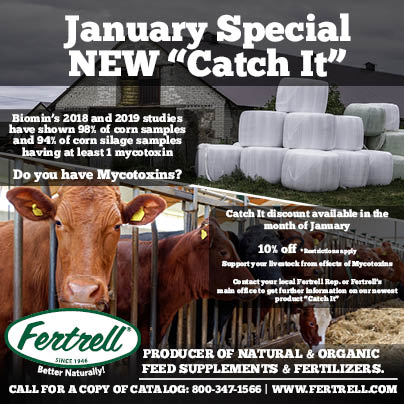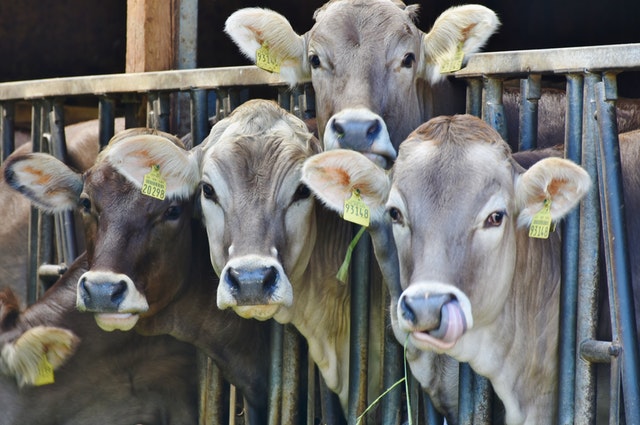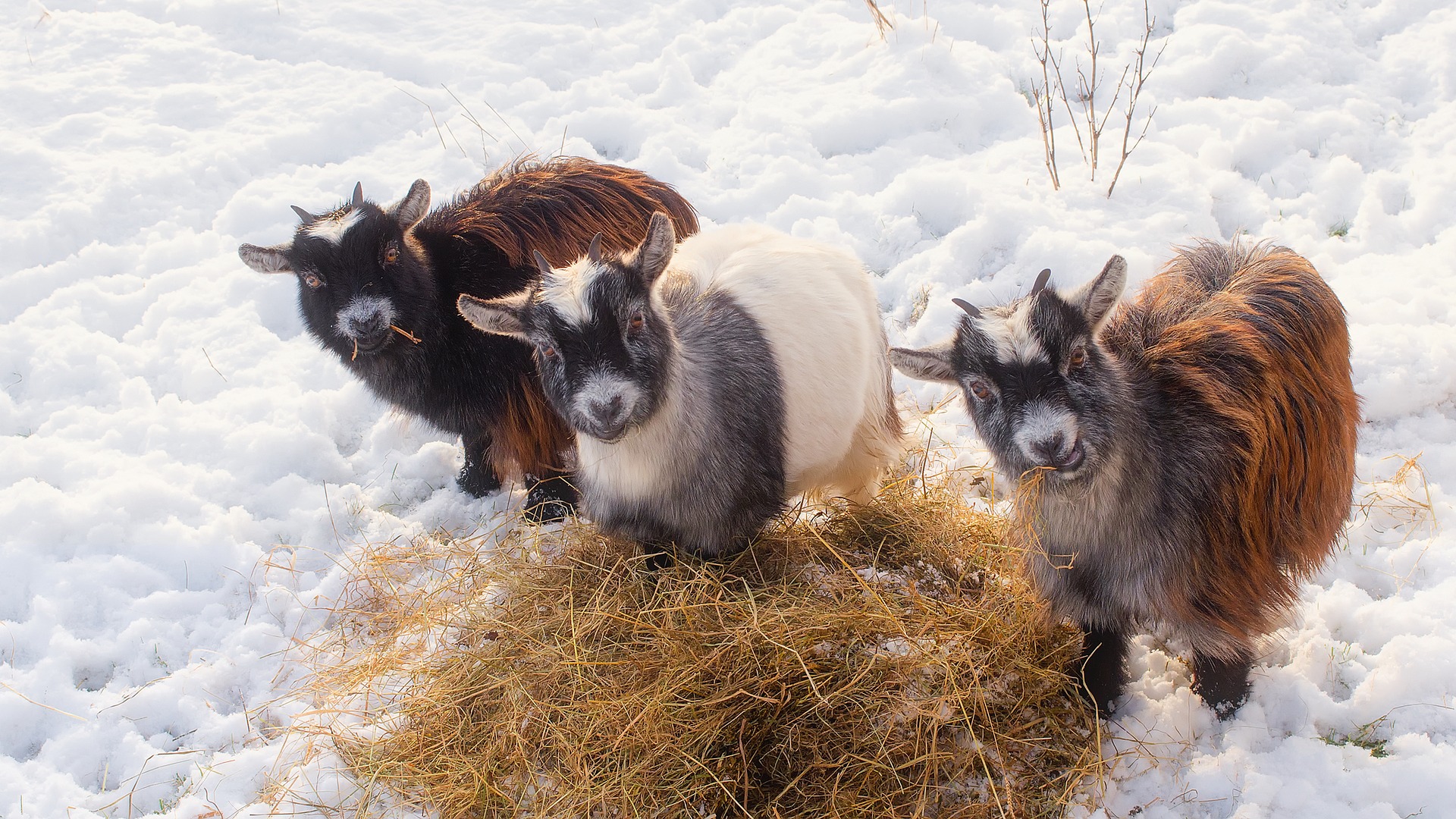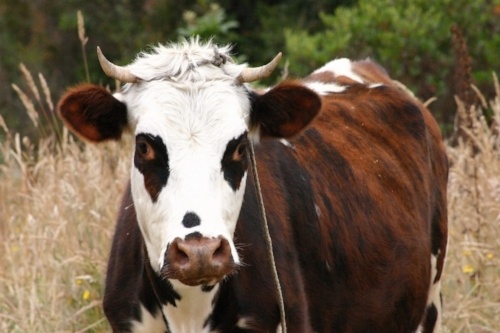Fertrell is reintroducing our Kelp Conditioner as Catch It! A product to help “catch” mycotoxins. Grab Catch It at 10% off during the month of January. Restrictions apply.
Fertrell Blog
A little history lesson, years ago Fertrell offered a dry cow mineral. It was called Hi Phos 3 – 15. Some of you probably remember this mineral blend. For several reasons, Hi Phos 3 – 15 went away. It had ingredients that were frowned upon by some organic certifiers and it was expensive. Sales had dwindled to a level low enough to remove it from our product line.
After that, feeding dry cows went along prettywell until recently. As we are formulating dry cow rations these days, we see deficiencies and imbalances that will lead to calving problems. I am seeing way too much potassium in many of the forages that are being fed to dry cows. We are also seeing way too many mold and mycotoxins in the forage
test being reported. These trends in forages and feedstuffs for dry cows has driven us back to needing a dry cow specific mineral blend.
A blend that can buffer the antagonistic inputs, support better health and balance cations and anions in the dry cow’s metabolism. The new dry cow mineral contains Mono-Sodium Phosphate for the best phosphorus source available in the market. The Mono-Sodium Phosphate ensures that critically needed phosphorus enters into the blood stream to condition and support reproductive organs. Especially the ovaries and uterus during times of stress.
Fertrell Dry Cow mineral also contains magnesium sulfate to supply high quality magnesium and sulfur. Magnesium is essential during the dry period to buffer excess potassium, lignin and high fiber. Magnesium is an effective mild laxative to keep the digestive tract moving smoothly as well. It has been found very effective in the first segment of the small intestinal tract where blockages are fairly common leading to bloat and or displaced abomasum. We also included Redmond Conditioner to aid in managing molds and toxins that may be in the grains and forages being fed. We feel that molds and mycotoxins are becoming more common in forages. I am not sure if there are more in recent years or if we have
As winter approaches, the switch to stored feeds begins. During this change, feed quality needs to be considered to maintain the health and production of your livestock. Your animals are relying on you to provide quality feeds to help them stay healthy and continue to meet performance expectations.
Something that comes to mind every year during the winter months is molds and toxins in forages. During the spring, summer and early fall, I don’t need to think about these because the availability of pasture and fresh forages seem to negate the affects of stored feed molds and toxins. However, during the winter months when feeding all stored or fermented feeds, the affects of molds and toxins become much more prevalent because that is all that is being fed.
About this Blog
The Fertrell Company blog is for farmers, backyard gardeners, and homesteaders alike. Learn from the experts on all things natural and organic for both soil and livestock.
Subscribe to Email Updates
Recent Posts
Posts by Topic
- Soils (18)
- Agronomy (13)
- Cows (13)
- Poultry (12)
- Dairy (8)
- Plant (7)
- Feed (5)
- plants (5)
- Herd (4)
- Mycotoxins (4)
- Vegetables (4)
- laying hens (4)
- soil testing (4)
- Forage (3)
- essential trace mineral (3)
- soil (3)
- swine (3)
- winter (3)
- Aragonite (2)
- Chickens as pets (2)
- Grazing (2)
- Testing (2)
- Turkeys (2)
- fertrell liquid #3 (2)
- grazing livestock (2)
- livestock (2)
- produce (2)
- smallscalegarden (2)
- soil test (2)
- start a garden (2)
- Berry Mix (1)
- Blue N 5-1-1 (1)
- Catch It (1)
- Dr. Paul (1)
- Fertrell Blue N 5-1-1 (1)
- Fertrell Super K 3-4-7 (1)
- Fertrell's Grazier’s Choice (1)
- Fertrell’s Liquid 3-4-3 (1)
- Fish emulsion (1)
- Graziers Choice (1)
- Grazing Season (1)
- Herbal Supplement Powder (1)
- Holly Care (1)
- Hoof Boost (1)
- Hoof Health (1)
- Horse Nutri-Balancer (1)
- Kelp conditioner (1)
- Lawn (1)
- Parasite Pressure Prevention (1)
- Preferred Calcium Source (1)
- RC GOLD (1)
- Water (1)
- baby chicks (1)
- backyard poultry (1)
- benefits of eggs (1)
- broilers (1)
- buying chicks (1)
- chickens (1)
- cold frame (1)
- copper (1)
- cover crops (1)
- dr.paul aloe pellets (1)
- early blight (1)
- fertrell high sulfur mineral (1)
- fertrell’s super k 3-4-7 (1)
- fertrell’s super n 4-2-4 (1)
- foliar feeding (1)
- free-choice (1)
- fungi (1)
- garden (1)
- garlic (1)
- hops (1)
- jet ag (1)
- kelp (1)
- kelp meal (1)
- late blight (1)
- liquid fertilization (1)
- loosing feathers (1)
- microbes (1)
- minerals (1)
- molt (1)
- molting (1)
- molting chicken (1)
- orchards (1)
- oxidate (1)
- pasture season (1)
- pigs (1)
- planting garlic (1)
- regalia (1)
- seed soak (1)
- seed starting (1)
- sow (1)
- stargus (1)
- straw-bale (1)
- strawbale (1)
- strawbale garden (1)
- sulfur (1)
- tissue testing (1)



